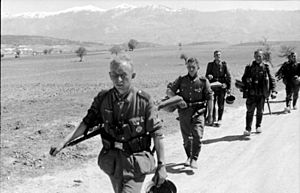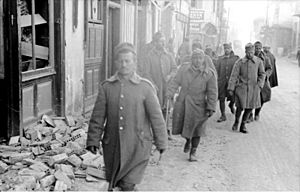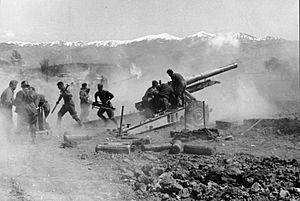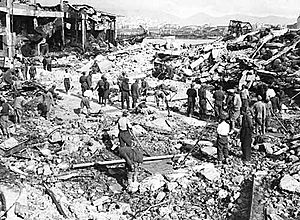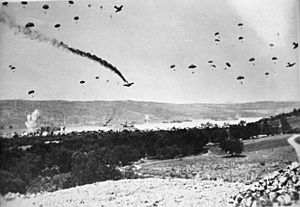German invasion of Greece facts for kids
Quick facts for kids Battle of Greece |
|||||||||
|---|---|---|---|---|---|---|---|---|---|
| Part of the Balkans Campaign during World War II | |||||||||
 Germany's attack on Greece |
|||||||||
|
|||||||||
| Belligerents | |||||||||
|
Allies: |
||||||||
| Commanders and leaders | |||||||||
| Strength | |||||||||
| Germany: 680,000 men 1,200 tanks 700 aircraft 1Italy: 565,000 men 463 aircraft 163 tanks Total: 1,245,000 men |
1Greece: 450,000 men Britain, Australia & New Zealand: 252,612 men 100 tanks 200–300 aircraft Total: 502,612 men |
||||||||
| Casualties and losses | |||||||||
| 1Italy: 19,755 dead 63,142 wounded 25,067 missing 3Germany: 7,599 dead 10,752 wounded 385 missing |
1Greece: 13,408 dead 42,485 wounded 1,290 missing 270,000 captured British Commonwealth: 903 dead 1,250 wounded 13,958 captured |
||||||||
| 1 Statistics about the strength and casualties of Italy and Greece refer to both the Greco-Italian War and the Battle of Greece (at least 300,000 Greek soldiers fought in Albania). 2 Including Cypriots and Mandatory Palestinians. British, Australian and New Zealand troops were c. 58,000. 3 Statistics about German casualties refer to the Balkans Campaign as a whole and are based on Hitler's statements to the Reichstag on 4 May 1941. |
|||||||||
The Battle of Greece, also known as the German invasion of Greece or Operation Marita, was a series of attacks on Greece by Italy and Germany during World War II. It began with Italy's invasion in October 1940, known as the Greco-Italian War. Germany joined in April 1941. These battles were part of the larger Balkans Campaign by the Axis powers. After the main battles, German forces also landed on the island of Crete in May 1941. The Axis powers won, leading to the occupation of Greece.
Understanding the Conflict
The Greco-Italian War Begins
When World War II started, Ioannis Metaxas, Greece's leader, wanted Greece to stay neutral. But Italy, led by Benito Mussolini, put more and more pressure on Greece. On 15 August 1940, an Italian submarine sank a Greek ship. Mussolini was annoyed that Adolf Hitler hadn't asked for his opinion on war plans. He wanted to show his power by taking Greece, thinking it would be an easy win.
On 28 October 1940, Italy demanded that its troops be allowed to enter Greece freely. Metaxas refused, a day now celebrated as Ohi Day (meaning "No Day"). Even before the deadline, Italian troops invaded Greece from Albania, which Italy controlled. The Greek army fought back strongly. Within three weeks, they pushed the Italians back into Albania, capturing important cities. Even with new Italian commanders and more soldiers, the Italian army struggled. A Greek attack in February 1941 aimed to capture more territory, but it faced strong resistance.
In March 1941, the Italians launched a counter-attack, but it failed badly despite having more soldiers. After a week and many casualties, Mussolini stopped the attack. Italy's invasion failed because Mussolini didn't send enough troops, didn't plan for bad weather, and attacked without surprising the Greeks or getting help from Bulgaria.
Hitler's Decision to Intervene
Britain had promised to help Greece if its independence was threatened. So, in November 1940, British planes arrived in Greece. British troops were also sent to Crete to protect a key bay.
Hitler decided to help Italy on 4 November 1940. He worried that British planes in Greece could bomb Romania's oil fields, which were vital for Germany's war effort. Also, Italy was struggling, and Hitler feared that if Italy was defeated, Britain would gain control of the central Mediterranean Sea. To prevent this, Hitler ordered his army to attack northern Greece from Romania and Bulgaria.
On 13 December 1940, Hitler planned the Greek campaign, called Operation Marita. The goal was to take the northern coast of the Aegean Sea and, if needed, all of Greece. To attack Greece, German forces would need to go through Yugoslavia or Bulgaria. Yugoslavia's leader refused to let German troops pass. But Bulgaria, which had old land disputes with Greece, agreed to let Germany use its territory in exchange for some Greek land.
British and Commonwealth Forces Arrive
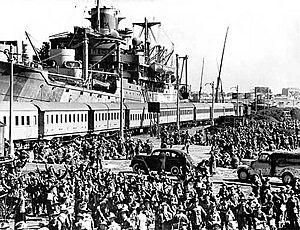
In January 1941, Greek General Alexandros Papagos asked Britain for nine fully equipped divisions and air support. Britain could only offer a small force. The Greeks initially refused, fearing it would provoke a German attack without enough help. However, British Prime Minister Winston Churchill wanted to create a new front in the Balkans to tie down German forces.
In February and March 1941, Australia and New Zealand agreed to send their troops from Egypt to Greece. They were worried about a repeat of the Gallipoli campaign, but felt they had to help Greece. By 24 April, over 62,000 British, Australian, and New Zealand troops had arrived in Greece. This force was called 'W' Force, led by Lieutenant-General Sir Henry Maitland Wilson.
German Invasion Begins
The Attack on Yugoslavia and Thessaloniki
On 6 April, German armies invaded Greece and Yugoslavia. The German XL Panzer Corps quickly pushed into Yugoslavia. By 8 April, they captured Prilep, cutting off a key railway line and isolating Yugoslavia. This allowed them to prepare an attack towards Florina, threatening to surround Greek and Allied forces.
The German 2nd Panzer Division also entered Yugoslavia from the east. Despite bad roads and some resistance, they reached Strumica. On 8 April, they broke through the Greek defenses near Doiran Lake. An armored group quickly moved towards Thessaloniki, entering the city on the morning of 9 April. Thessaloniki was captured after a battle with three Greek divisions. About 60,000 Greek soldiers were taken prisoner.
The Metaxas Line
The Metaxas Line was a strong defensive system built by Greece along its border with Bulgaria. It had concrete bunkers and fortifications, similar to France's Maginot Line. About 70,000 Greek soldiers defended this line.
The Germans attacked the Metaxas Line on 6 April. Despite strong air support, the German 5th Mountain Division faced heavy resistance and suffered many casualties. Two German battalions were almost destroyed trying to reach Fort Rupel. Most of the 24 forts held out. However, the German 6th Mountain Division crossed a high, snow-covered mountain pass that the Greeks thought was impossible to cross. On the evening of 7 April, they reached the railway line to Thessaloniki.
By 9 April, with Thessaloniki captured, the Greek forces defending the Metaxas Line were ordered to surrender. Some smaller forts continued to fight for a few more days until heavy artillery was used against them. The defenders of the Metaxas Line managed to slow down the German advance, giving some Greek troops time to escape by sea.
Allied Retreat and Greek Surrender
After the Germans broke through, General Wilson decided to pull back all British forces to the narrow pass at Thermopylae, a famous historical battle site. On 14 April, German tanks tried to cross the Haliacmon river but were stopped by strong Allied fire. The Allies set up new defenses at the Platamon tunnel, Olympus pass, and Servia pass. These positions were held by New Zealand and Australian brigades.
For three days, the German advance was stopped by these determined defenders. On 15 April, a German attack on the Platamon ridge was pushed back by New Zealand soldiers. However, the Germans reinforced and attacked again. The New Zealanders were eventually surrounded and had to withdraw.
Meanwhile, the Greek army fighting in Albania was reluctant to retreat. They had suffered many casualties and were running out of supplies. On 13 April, an elite German SS unit was sent to cut off the Greek army's retreat route. On 18 April, General Wilson told Papagos that British forces would continue fighting at Thermopylae if the Greek army from Albania could cover their flank.
On 20 April, the commander of Greek forces in Albania, Lieutenant General Georgios Tsolakoglou, decided to surrender his army of fourteen divisions. He wanted to surrender only to the Germans, not the Italians, who had not earned the victory. Hitler agreed to this secret surrender. Mussolini was angry and ordered attacks against the Greek forces, but these were pushed back. Finally, on 23 April, an armistice was signed with Italian participation. Greek soldiers were allowed to go home after their units were disbanded.
The Last Stand at Thermopylae
The Germans realized the British were evacuating troops by ship. Their goal became to stop this evacuation. On 23 April, the British rearguard was ordered to make a final stand at Thermopylae to allow the main forces to escape. New Zealand and Australian brigades held the passes. The Germans attacked on 24 April, facing fierce resistance and losing 15 tanks. The Allies held out all day, then retreated towards the evacuation beaches.
The Fall of Athens and Evacuation
After Thermopylae, the British rearguard withdrew to a position south of Thebes, setting up a last defense before Athens. On the morning of 27 April 1941, the first German troops entered Athens. They captured large amounts of supplies. The people of Athens had been expecting the Germans and stayed in their homes. Athens Radio broadcast a message telling Greeks to stay strong and proud.
The Germans went straight to the Acropolis and raised the Nazi flag. A famous story says the Greek guard, Konstantinos Koukidis, took down the Greek flag, wrapped himself in it, and jumped off the Acropolis rather than hand it over. Many Greeks believed this story and saw him as a hero.
General Archibald Wavell, the British commander in the Middle East, had already authorized evacuation plans. On 21 April, the decision was made to evacuate Allied forces to Crete and Egypt. On the night of 24 April, 5,200 New Zealand soldiers were evacuated from Porto Rafti. On 25 April, about 10,200 Australian troops were evacuated from Nafplio and Megara.
The Germans tried to cut off the British retreat by seizing bridges over the Corinth Canal with an airborne attack. The attack was successful until a British shell destroyed the bridge. German forces pursued the Allies across the Peloponnese. By 30 April, about 50,000 soldiers had been evacuated. However, the German air force attacked the ships, sinking at least 26. The Germans captured about 8,000 Allied troops who couldn't be evacuated. The Greek Navy played a vital role in the evacuation, suffering heavy losses.
Aftermath
Triple Occupation of Greece
After the battle, mainland Greece was divided and occupied by Germany, Italy, and Bulgaria. Italy took most of the country. German forces occupied important areas like Athens, Thessaloniki, and parts of Crete. Bulgaria occupied territory in the northeast. The occupation was very hard on Greek civilians, with many suffering from hunger. Several resistance groups fought against the occupying forces.
The Battle of Crete
On 25 April 1941, the Greek King and his government moved to Crete. On 20 May 1941, Nazi forces attacked Crete in a massive airborne invasion, targeting the island's main airfields. After seven days of fierce fighting, Allied commanders decided the situation was hopeless and ordered a withdrawal. By 1 June 1941, the evacuation was complete, and Crete was under German control. The Germans suffered heavy losses in this battle. Hitler later said he would not launch such large airborne operations again.
Why the Axis Won
The Battle of Greece ended with a complete German and Italian victory. Britain did not have enough military resources to fight major wars in both North Africa and the Balkans at the same time.
Here are some main reasons for the Axis victory:
- Germany had much better ground forces and equipment.
- Most of the Greek army was busy fighting the Italians in Albania.
- Germany had total control of the air.
- The British forces sent to Greece were too small.
- The Greek army was not well-equipped with modern weapons.
- Greece's ports, roads, and railways were not good enough for moving large armies.
- There was no single command for the British, Greek, and Yugoslav forces, and they didn't cooperate well.
- Turkey stayed neutral.
- Yugoslavia's resistance collapsed very quickly.
Impact on Operation Barbarossa
Some historians argue that the Battle of Greece delayed Operation Barbarossa, Germany's invasion of the Soviet Union. Hitler himself reportedly said that if Italy hadn't attacked Greece, the war might have gone differently. He believed they could have reached Leningrad and Moscow before the Russian winter.
However, other historians disagree. They say that the main reasons for delaying Operation Barbarossa were problems with German supplies and an unusually wet winter. Most historians now believe that the Balkan campaign had little effect on the final start date of the invasion of the Soviet Union.


